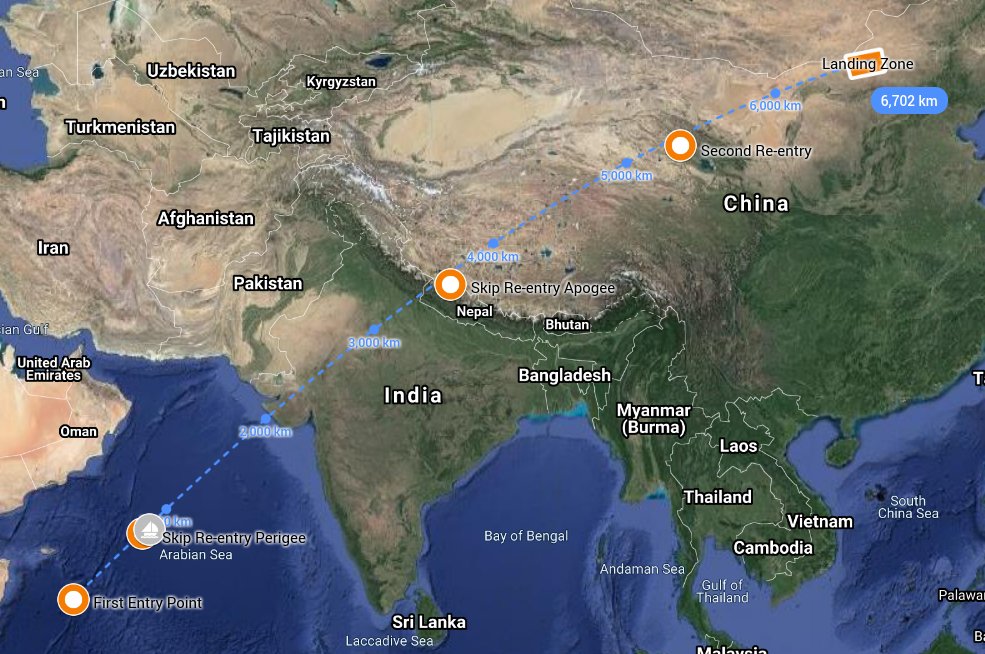Here's a plot of an estimated ground track for the #Change5 re-entry.
This THREAD will discuss:
- Evidence supporting this ground track,
- Alternatives that have been excluded,
- 'Skip' re-entry profile visibility characteristics,
- State vector confirmation of timings/position.
This THREAD will discuss:
- Evidence supporting this ground track,
- Alternatives that have been excluded,
- 'Skip' re-entry profile visibility characteristics,
- State vector confirmation of timings/position.
Two possible re-entry ground tracks have been explored. The one presented is favoured because the tracking ship Yuan Wang 3 is now presently at the 'skip re-entry perigee'. Using AIS data dug up by @steffanwatkins the ship has been loitering in the area for a day or so now.
@Cosmic_Penguin noted the following graphics posted during pre-launch coverage of training efforts which showed the location of Yuan Wang 3 and the major re-entry event locations. Despite some oddness in the presented data the plan looks solid. https://twitter.com/Cosmic_Penguin/status/1331994377581826049
This NOTAM indicates the location of the landing zone and also constrains the timing of the events leading up to re-entry. Coupled with the points from the CNSA training plot and Yuan Wang 3's present location a convincing case emerges. https://twitter.com/StarRin87819971/status/1338240673154297856
@M_R_Thomp offered an initial state vector for the return of #Change5 that did fit closely to the 'First Entry Point'. We diverged to study a competing ground track offered by @esa that suggests a track over Yemen.
The @esa plots posted are to popularize their support for planned radio comms. Fitting our state vector to this 'first entry point' does not support the present location of Yuan Wang 3 as the ship will be below the required skip altitude's horizon. https://www.esa.int/ESA_Multimedia/Images/2020/11/ESA_tracks_Chang_e-5_Moon_mission
The presented trajectory is a 'simplification' and makes the assumption that the s/c is coming in and not skipping off the atmosphere to slow down. But understanding that it does skip up is important to understand that the s/c may not be visible for a portion of the re-entry.
Research into the re-entry characteristics of the Apollo missions that followed a similar profile shows that the plasma around the capsule may fade significantly during the parabolic rise and fall from apogee. As we have no other source of illumination this may limit observation.
The plot below and CNSA plot above show a significant distance is covered by the parabolic apogee skip arc used. Effectively skipping right over the Indian sub-continent. If the s/c rises above 100km as suggested above, then little will likely be seen during this phase.
As most of re-entry will likely be above the atmosphere above India one also needs to note the Sun is also well set along the re-entry track. As the s/c is at a very low altitude for the entire re-entry event reflected sunlight will not provide a source of illumination.
This analysis is not intended to claim the re-entry will not be visible along the ground track. These notes support the parts along the ground track closest to the 'skip re-entry perigee' and '2nd re-entry' will be the locations to have the best chance of seeing it.
Due to limited tracking data the current state vector for the returning #Change5 is still a work in progress. As we get closer to re-entry we will fit the data and attempt to provide closer timings and ground track details.
H/Ts and References:
@MarineTraffic for AIS Data
https://infinitehistory.mit.edu/video/apollo-4-mission-1967
https://lib.dr.iastate.edu/cgi/viewcontent.cgi?article=16811&context=rtd
@MarineTraffic for AIS Data
https://infinitehistory.mit.edu/video/apollo-4-mission-1967
https://lib.dr.iastate.edu/cgi/viewcontent.cgi?article=16811&context=rtd

 Read on Twitter
Read on Twitter









